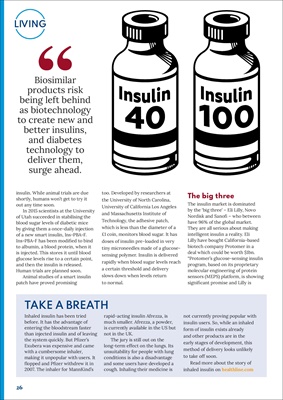
26
LIVING
program, based on its proprietary
molecular engineering of protein
sensors (MEPS) platform, is showing
significant promise and Lilly is
excited to enhance our diabetes
pipeline with the company's
innovative technology," said Ruth
Gimeno, vice president, diabetes
research and clinical investigation
at Lilly when the acquisition was
announced last July.
Novo Nordisk paid a reported
$800m for Bristol University biotech
spin-off Ziylo in 2018. Ziylo has
developed an innovative technology
platform which uses glucosebinding molecules
that can act as
an on-off switch for insulin. Sanofi's
smart insulin projects include one
at Monash University in Australia,
also supported by JDRF, where a
team is working on glucose-sensing
nanoparticles.
These smart insulins will be
exciting when they finally arrive, but
they won't be perfect. There's likely
to be plenty of work to do to improve
them further, for example, insulins
that require fewer injections or being
free of the need for basal insulin.
But for those enhancements we're
looking long years ahead.
And the rest
There's talk of insulin patches, gel
capsules, nano-implants and more to
deliver insulin in the future, but longhoped-for
insulin pills and inhaled
insulin also remain tantalising.
People understandably prefer the
idea of taking a pill to sticking
needles in themselves. Several are in
development but challenges remain
around a pill surviving its passage
through the digestive system and
poor absorption. Two projects have
shown promise so far.
Supported by JDRF, Indian
biopharma company Biocon is
developing insulin tregopil IN105 as a mealtime
oral insulin pill
for people with type 1 and type 2
diabetes. Human trials are underway.
American-Israeli company Oramed's
ORMD-0801 is designed to be
used at mealtimes for people with
Type 1 diabetes and at bedtime for
those with Type 2. A phase 2 study
demonstrated it to be both safe and
effective, with no adverse events and
no hypoglycaemia. At present this is
looking likely to be the first insulin
pill to go on market, but we are
still five years or more away from it
becoming available.
There's also a desire to tackle the
issue of the rising cost of insulin.
Some see the development of generic
or biosimilar insulins as the way to
make this life-saving therapy more
affordable once patents expire.
Biosimilar insulins are identical
in their amino acid sequence to
an existing proprietary insulin
but creating them is trickier than
producing more straightforward
generic medicines, such as statins.
Insulin is a large, complex protein, so
even small changes in the structure
and manufacturing process can alter
the way the drug works and getting
Biosimilar
products risk
being left behind
as biotechnology
to create new and
better insulins,
and diabetes
technology to
deliver them,
surge ahead.
TAKE A BREATH
Inhaled insulin has been tried
before. It has the advantage of
entering the bloodstream faster
than injected insulin and of leaving
the system quickly. But Pfizer's
Exubera was expensive and came
with a cumbersome inhaler,
making it unpopular with users. It
flopped and Pfizer withdrew it in
2007. The inhaler for MannKind's
rapid-acting insulin Afrezza, is
much smaller. Afrezza, a powder,
is currently available in the US but
not in the UK.
The jury is still out on the
long-term effect on the lungs. Its
unsuitability for people with lung
conditions is also a disadvantage
and some users have developed a
cough. Inhaling their medicine is
not currently proving popular with
insulin users. So, while an inhaled
form of insulin exists already
and other products are in the
early stages of development, this
method of delivery looks unlikely
to take off soon.
Read more about the story of
inhaled insulin on healthline.com